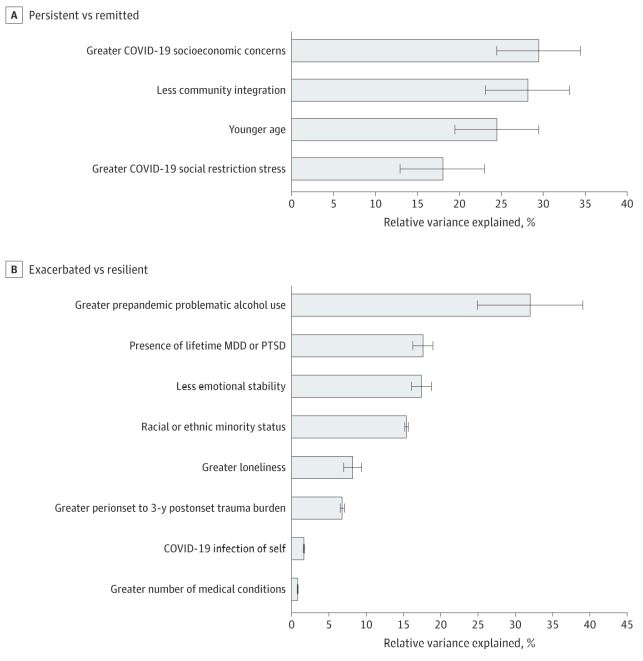
Click to Enlarge: Relative Importance Analysis of Factors Associated With Courses of Distress. Error bars represent 95% CIs. Only significant variables from regression models were included in analyses. Source: JAMA Network Open
WEST HAVEN, CT — With work disruptions, social isolation and economic concerns, the pandemic understandably caused significant distress for many veterans.
For the majority, fortunately, the distress was relatively short-lived. But for a significant minority, it persisted two years into the pandemic, signaling underlying issues that should be addressed, according to a new study by researchers with the VA Connecticut Healthcare System in, West Haven, CT.
Building upon an earlier study which characterized the prevalence of distress–as defined by positive screens for major depressive disorder, generalized anxiety disorder, or post-traumatic stress disorder–in veterans before and one year into the COVID-19 pandemic, the new study analyzed two additional years of longitudinal data and identifying factors associated with exacerbated and persistent courses of distress. 1
The three-year longitudinal study, reported Feb. 23, 2023, in JAMA Network Open, was divided into three phases:
- Pre-pandemic (Fall 2019),
- Peri-pandemic (Fall 2020, which included the fall and winter COVID-19 surge before widespread availability of COVID-19 vaccines) and
- Two-year post-onset (Summer 2022, at which point the majority of U.S. adults were vaccinated and mask mandates and social distancing policies no longer enforced)
Veterans were categorized into one of five groups based on the presence or absence of distress at each time point:
- resistant, signifying participants with no positive screens;
- persistent, for positive screens at each time point;
- remitted, for positive screens at pre-pandemic only;
- resilient, with a positive screen at peri-pandemic only; and
- exacerbated, with positive screens at peri-pandemic and two-year post-onset but not pre-pandemic
Logistic regression and relative importance analysis examined demographic and clinical factors associated with exacerbated and persistent courses of distress.
Of the 2,289 veterans studied, the majority (83.7%) were classified as resistant. The rest exhibited resilient (5.3 %), persistent (5.0 %) remitted (3.5%) or exacerbated (2.5%) courses of distress, the study found.
In the full sample, except for those 65 and older, distress increased significantly (by 51 %) from the pre-pandemic to peri-pandemic period but returned to pre-pandemic levels two years later. In veterans aged 18 to 44, distress increased 64% and in female veterans increased 62%. The researchers speculated higher increases in the younger and female veterans were due to unique pandemic stressors, such as school closures and work and relationship disruptions. Nevertheless, they reported, distress prevalence had returned to pre-pandemic levels two years later, which aligns with prior work suggesting resilience is the typical or most common behavioral response to stressful events.
Relative importance analysis results showed that COVID-19 socioeconomic concerns and less community integration had the greatest effect on persistent vs. remitted distress, while greater pre-pandemic problematic alcohol use had the largest effect size for exacerbated vs resilient distress.
Despite this overall pattern of resilience, a significant minority of veterans had exacerbated (2.5%) or persistent (5.0%) courses of distress, the researchers reported. Based on the total U.S. veteran population, this would translate into approximately 450,000 and 900,000 veterans, respectively. Veterans with exacerbated distress two years into the pandemic reported greater pre-pandemic alcohol use problems, greater likelihood of lifetime major depressive disorder or PTSD and lower emotional stability. Possible mechanisms underlying these findings include alcohol-related neuroinflammatory or metabolic changes and higher levels of stress sensitization, they wrote.
“Pandemic-related socioeconomic concerns were significantly associated with persistent distress,” the authors concluded. “Younger age, lower community integration, and higher pandemic-related social restriction stress were also associated with this outcome.” These findings, they wrote, underscore the importance of assessment, treatment and policy strategies that target the economic and social needs of veterans with these risk factors.
- Fischer IC, Na PJ, Harpaz-Rotem I, Krystal JH, Pietrzak RH. Characterization of Mental Health in US Veterans Before, During, and 2 Years After the Onset of the COVID-19 Pandemic. JAMA Netw Open. 2023 Feb 1;6(2):e230463. doi: 10.1001/jamanetworkopen.2023.0463. PMID: 36821116; PMCID: PMC9951035.

